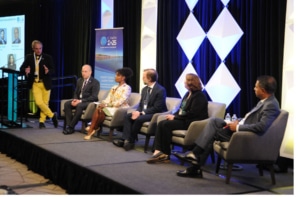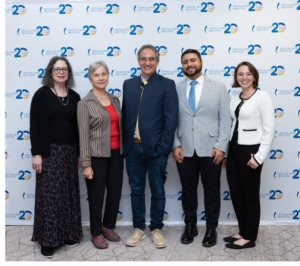
Day 2 of the C-Path Global Impact Conference built on the momentum of opening day, bringing together leaders, advocates, and researchers to explore how patient voices and innovative partnerships are transforming drug development.
We began with a deep dive into modernizing clinical trials, where speakers underscored how adaptive trial designs and real-world data are reshaping the future of randomized controlled trials.
“Before we’re executing trials and finalizing protocols, we’re taking steps to really look at who the patient is to make sure they are reflected in the trials,” said LaShell Robinson (Takeda). “I know that at times people think this is slowing down the trial, but if you think about it logically starting where the patient is and trying to make those connections, engaging with patient advocacy to understand the different patient journeys, actually speeds up the trial.”
“When I paint with a broad brush on what’s working in industry and what’s not working in industry, what’s working is C-Path, and C-Path is not congratulated enough on this intersection — the quality of the regulatory science that has happened very quietly is extraordinary,” Amitabh Chandra (Harvard Business School).
The conversation continued with a powerful patient-focused drug development panel, centered on the lived experiences of patients, caregivers, and advocates in shaping more compassionate, effective treatments.
The late morning session, Connecting the Dots: Disease Interception in Parkinson’s and Type 1 Diabetes, highlighted surprising parallels between the two diseases and the opportunities for cross-disease learning to advance early intervention.
At midday, attendees explored three breakout sessions running in parallel:
- Applying FDA’s PFDD Roadmap to Digital Measures in Rare Neurodegenerative Diseases – showcasing how patient input and regulatory alignment guide innovative outcome assessments.
- C-Path’s Disease Model Coalition – rethinking traditional approaches to accelerate therapy development across therapeutic areas.
- Critical Path Data and Analytics Platform (CP-DAP) Demo – a hands-on look at C-Path’s secure, collaborative platform advancing regulatory-grade research.

The afternoon continued with sessions on greater equity in Parkinson’s research through the Global Evidence in Medicine-Parkinson’s Disease initiative, where patient advocates and scientists emphasized the urgent need to amplify women’s voices in clinical trials, and a compelling discussion on surrogate endpoints in PKD and Alzheimer’s.
We closed the day with a forward-looking panel on public-private partnerships and early disease interception, underscoring the transformative potential of collaboration across sectors:
Day 2 left us inspired by the ways those with lived experience, regulators, researchers and industry are coming together to reimagine what’s possible.


